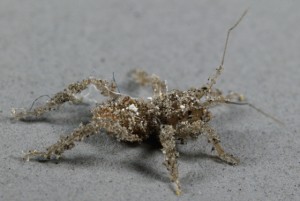
Masked Hunter
Masked hunter (Reduvius personatus)
The masked hunter is a curious oddity of a bug that occurs throughout the US and southern Canada. It was introduced into the U.S. from Europe before the beginning of the century. Both adults and nymphs are predators that feed on other insects including flies, carpet beetles, mealworms and bed bugs. The adult bug is dark brown or black and about 3/4 of inch long. The nymphs or immatures are covered with microscopic hairs which catch and hold dust, lint, and other small particles of debris. This camouflage helps the nymph to ambush prey, hence the common name, “masked hunter.” If threatened or handled roughly, these insects will bite people with their needle-like mouthparts. Their bite is very painful and can result in localized swelling.
This insect prefers dry habitats and therefore is usually found only indoors and other protected sites. This does not mean they are only found in the living area of the house, but it is possible they found their way in from attics and crawlspaces where their prey (other insects) may be plentiful. Normally, they occur in very low numbers when found in homes, Control measures beyond that of a flyswatter are not needed unless they are become numerous. If this occurs, efforts should be made to reduce the number of other insects the masked hunter is utilizing as prey. An aggressive approach would involve spraying attics, basements and crawlspaces with a persistent insecticide registered for use inside homes. Living areas should only be sprayed with insecticides that are registered for use inside homes.




 Print
Print Email
Email




